|
The Ancient Game of the Mandarins
by Bob Brooke
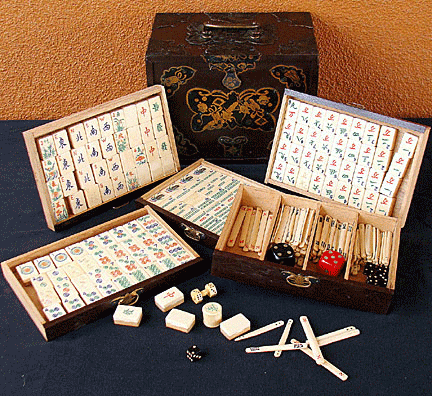 Mahjong
has been played in China for over 3,000 years, originating in Canton
during the Qing Dynasty before the days of Confucius. Only Mandarins
played it, and the early tiles were handmade from ivory. Mahjong
has been played in China for over 3,000 years, originating in Canton
during the Qing Dynasty before the days of Confucius. Only Mandarins
played it, and the early tiles were handmade from ivory.
In 1911, when China became a republic, the game became popular with
all classes of people. Mahjong makers produced tiles of bone and
bamboo, or just bamboo, which was cheaper and easier to obtain than
ivory. The British brought the game from China to England, and
eventually to the United States in the early 1920s.
As a game of skill, strategy, and calculation, Mahjong became the
rage. Soon there were as many variations to the rules of the game as
groups of people playing it. During the Roaring Twenties its
popularity soared, but that didn't last long because no one could
agree on which rules to follow. The National Mahjong League
standardized the rules in 1937, but by this time most players had
gone back to playing bridge.
The Game of Mahjong
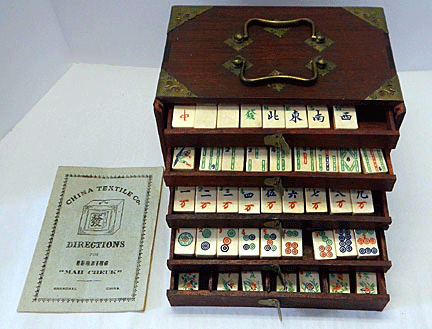 At
first glance, the game of Mahjong may seem confusing, even chaotic,
especially if the players are experts. They use strange terms, and
the rapidity of calling and discarding tiles appears maddening. The
goal of Mahjong is to complete as many levels as possible until at
least one player has no more moves left. At that point the game
ends. At
first glance, the game of Mahjong may seem confusing, even chaotic,
especially if the players are experts. They use strange terms, and
the rapidity of calling and discarding tiles appears maddening. The
goal of Mahjong is to complete as many levels as possible until at
least one player has no more moves left. At that point the game
ends.
Players use a set of 144 tiles based on Chinese characters and
symbols. Some variations may omit some tiles and/or add unique ones.
In most variations, each player starts out with 13 tiles. In turn,
player each draw and discard tiles until they complete a hand using
the 14th drawn tile to form four melds, or sets, and a pair, or eye.
Players follow standard rules when drawing tiles and robbing pieces
from other players. Standard rules also apply to the use of
“simples,” or numbered tiles, and honors, winds and dragons, the
kinds of melds allowed, how to deal the tiles, and the order of
play.
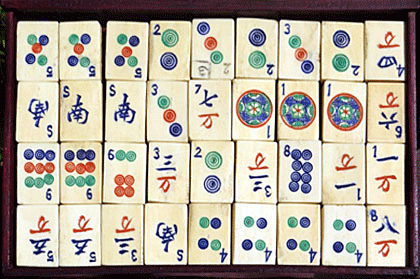
Mahjong tiles are divided into five groups—suits, dragons, winds,
flowers and jokers. There are four winds—north, east, west, and south,
and four pieces of each. Three dragons are green, white and red, and
there are four of each color. There are three suits—dots, craks and bams,
and each suit is numbered from one to nine, with four tiles of each
number. Each set also includes eight flower tiles and, depending on the
manufacturer of the set, these may depict flowers, mandarins, or seasons
of the year. Eight jokers complete the pieces.
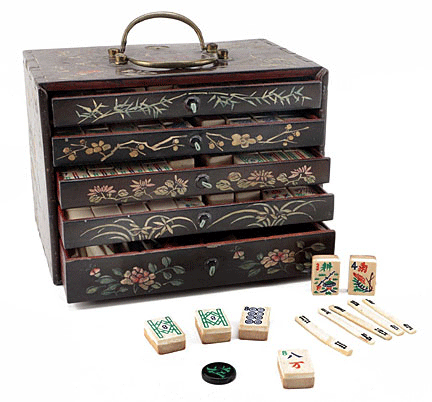 Players
follow procedures. Each builds a wall 19 tiles face down, two tiers
high, in front of each other seated around a table in positions set as
points of a compass—North, East, West, and South. The player designated
as East starts the game by dealing out the tiles to the others. Players
pass the tiles between them In a specified sequence before the game
begins, as each player gets rid of unwanted tiles, and hopes to receive
pieces which fit a combination in his hand. The game proceeds with
drawing and discarding tiles until one player completes a hand which
contains 14 tiles in a specific combination, then that player calls
"mahjong." Combinations include hands similar to a game of rummy—three
of a kind, four of a kind, consecutive runs, etc. Each combination has a
listed value for scoring. Sometimes, players draw all the tiles before
anyone gets mahjong. It ‘s important for participants to play
defensively so that other players don’t complete a hand. Only one player
can mahjong. Players
follow procedures. Each builds a wall 19 tiles face down, two tiers
high, in front of each other seated around a table in positions set as
points of a compass—North, East, West, and South. The player designated
as East starts the game by dealing out the tiles to the others. Players
pass the tiles between them In a specified sequence before the game
begins, as each player gets rid of unwanted tiles, and hopes to receive
pieces which fit a combination in his hand. The game proceeds with
drawing and discarding tiles until one player completes a hand which
contains 14 tiles in a specific combination, then that player calls
"mahjong." Combinations include hands similar to a game of rummy—three
of a kind, four of a kind, consecutive runs, etc. Each combination has a
listed value for scoring. Sometimes, players draw all the tiles before
anyone gets mahjong. It ‘s important for participants to play
defensively so that other players don’t complete a hand. Only one player
can mahjong.
"Old Hong Kong Mahjong" uses the same basic features and rules as the
majority of the different variations of the game. This form of Mahjong
uses all of the tiles of the commonly available sets, includes no exotic
complex rules, and has a relatively small set of scoring sets/hands with
a simple scoring system.
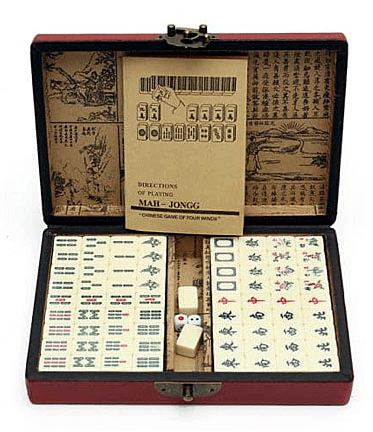 By
the early 1900s, Mahjong had become a craze in the United States. The
first Mahjong sets came to America from China. Some came in handsome
rosewood boxes with separate drawers for the stones, wind, flowers, and
other Mahjong tiles. The best of these had fine joinery and ornate brass
hardware and dice, but many sets came packed in handpainted cardboard
boxes. While tiles in less expensive sets were wooden, those in deluxe
sets could be ivory or jade. By
the early 1900s, Mahjong had become a craze in the United States. The
first Mahjong sets came to America from China. Some came in handsome
rosewood boxes with separate drawers for the stones, wind, flowers, and
other Mahjong tiles. The best of these had fine joinery and ornate brass
hardware and dice, but many sets came packed in handpainted cardboard
boxes. While tiles in less expensive sets were wooden, those in deluxe
sets could be ivory or jade.
Mahjong’s popularity continued into the 1950s, then waned in the second
half of the 20th century, but surged again in the 1990s after the
publication and film version of Amy Tan’s "The Joy Luck Club."
Antique Mahjong Sets
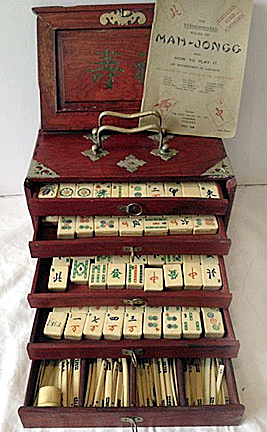 Finding
a complete antique set of tiles requires some perseverance. The
completeness of a set depends on the variation of the game being played.
As with a deck of cards, it’s essential that all tiles match. Early sets
contained 144 tiles, a pair of dice, betting sticks which were used much
like poker chips to represent money for wagers, markers portraying the
seated players, a counter reflecting the four winds which the “bettor,”
a fifth player, used to indicate his or her choice of the winner, and
some kind of suitable box in which to store all the pieces. Craftsmen
made these boxes of fine, carved woods, inlaid with mother of pearl or
fitted with silver or brass handles. Sets made after 1923 often came
with a small instruction book. Finding
a complete antique set of tiles requires some perseverance. The
completeness of a set depends on the variation of the game being played.
As with a deck of cards, it’s essential that all tiles match. Early sets
contained 144 tiles, a pair of dice, betting sticks which were used much
like poker chips to represent money for wagers, markers portraying the
seated players, a counter reflecting the four winds which the “bettor,”
a fifth player, used to indicate his or her choice of the winner, and
some kind of suitable box in which to store all the pieces. Craftsmen
made these boxes of fine, carved woods, inlaid with mother of pearl or
fitted with silver or brass handles. Sets made after 1923 often came
with a small instruction book.
Because many manufacturers and importers glued their product labels to
the insides of the boxes, and because the cardboard boxes tended to wear
out, we know less about some of these early sets than we’d like. In
fact, today many antique Mahjong sets are sold in the attaché cases that
replaced the original cardboard boxes. These cases are frequently lined
with velvet, with fake alligator skin or leather on the outside. They
look vintage, and they may be quite old, but they are usually not
original.
Of the companies that imported Mahjong games into the United States,
Piroxloid Products Corporation stands out. It’s peak appears to have
been the 1920s. Based in New York, as were many of the other game
companies of that era, Piroxloid imported Mahjong sets with most of the
characteristics described above, as well as sets with Bakelite tiles and
racks.
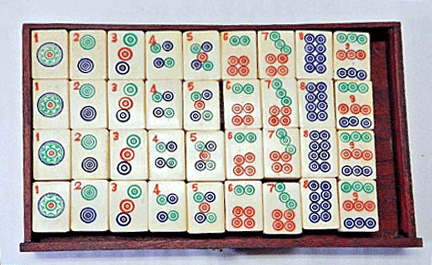
Butterscotch Bakelite tiles were quite popular. Piroxloid marbled its
Mahjong racks in deep chocolates and vibrant greens, and made dice in a
color called cherry juice. Some of the most collectible Piroxloid sets
include a booklet called "Standard Rules for The Ancient Game Of The
Mandarins," written by Piroxloid’s in-house Mahjong expert, Hugo
Manovill. In fact, there were dozens of books and booklets published
during the 1920s explaining the rules of the game to Mahjong-crazed
Americans.
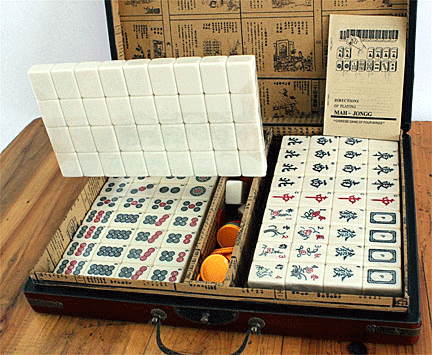 Another
well-known 1920s U.S. manufacturer of Mahjong sets was Parker Brothers,
Inc. While the Piroxloid sets came with a Manovill rulebook, Parker
Brothers sets came with "Babcock Rules." Parker Brothers sets had model
names, from the inexpensive Hong Kong set in a cardboard box to the
pricier Newport and Tuxedo sets, the latter of which came in a mahogany
box with French Ivory laminated onto teak tiles. Another
well-known 1920s U.S. manufacturer of Mahjong sets was Parker Brothers,
Inc. While the Piroxloid sets came with a Manovill rulebook, Parker
Brothers sets came with "Babcock Rules." Parker Brothers sets had model
names, from the inexpensive Hong Kong set in a cardboard box to the
pricier Newport and Tuxedo sets, the latter of which came in a mahogany
box with French Ivory laminated onto teak tiles.
Bakelite had been invented in 1907. Though it was popular, it was hardly
the only plastic available to Mahjong manufacturers. Pyralin was an
ivory-colored celluloid-based material favored by Pung Chow, which had
factories in New Jersey and Massachusetts. In the mid-1920s, Pung Chow’s
produced its Pyralin Mahjong tiles either as solid tiles or as veneers
on inexpensive wooden tiles.
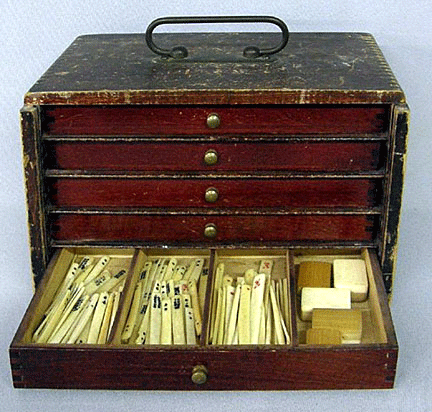 Then,
in 1927, when the Bakelite patent ran out, numerous other companies such
as Catalin introduced their own line of Mahjong tiles in an even greater
range of colors. Whereas the original Bakelite tiles and racks were
opaque and marbled, Catalin tiles had a translucent quality. Then,
in 1927, when the Bakelite patent ran out, numerous other companies such
as Catalin introduced their own line of Mahjong tiles in an even greater
range of colors. Whereas the original Bakelite tiles and racks were
opaque and marbled, Catalin tiles had a translucent quality.
Tyl produced Mahjong sets during the 1930s and ’40s. Some of Tyl’s
nicest sets had two-tone tiles, with butterscotch Bakelite on top and
burgundy Bakelite on the back to match the racks. The betting chips made
for sets of this vintage were probably some type of polystyrene, which
is why they produced satisfying, metallic clinks when stacked or knocked
together.
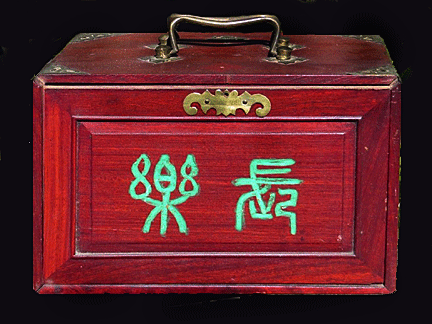 In
the 1940s, Met Games of New York produced many Mahjong sets which had
tiles and racks made from translucent Catalin. Met used its tile designs
over and over on different models. The company also made model with
unique tile images such as a parrot. Also collectible are Met tiles that
are "enrobed," which means that instead of looking like a sandwich, the
tile suggests a piece of sushi. In
the 1940s, Met Games of New York produced many Mahjong sets which had
tiles and racks made from translucent Catalin. Met used its tile designs
over and over on different models. The company also made model with
unique tile images such as a parrot. Also collectible are Met tiles that
are "enrobed," which means that instead of looking like a sandwich, the
tile suggests a piece of sushi.
Finally, E.S. Lowe made very handsome sets in the 1940s and ’50s. It
packed its sets in fake-alligator cases and had "Mah-Lowe" joker tiles.
Lowe sets are common, particularly the ones made in the 1960s, but a
vintage set from prior to that decade in good condition is still
considered a catch.
<
Back to More Antique Spotlights
Next Article >
|
